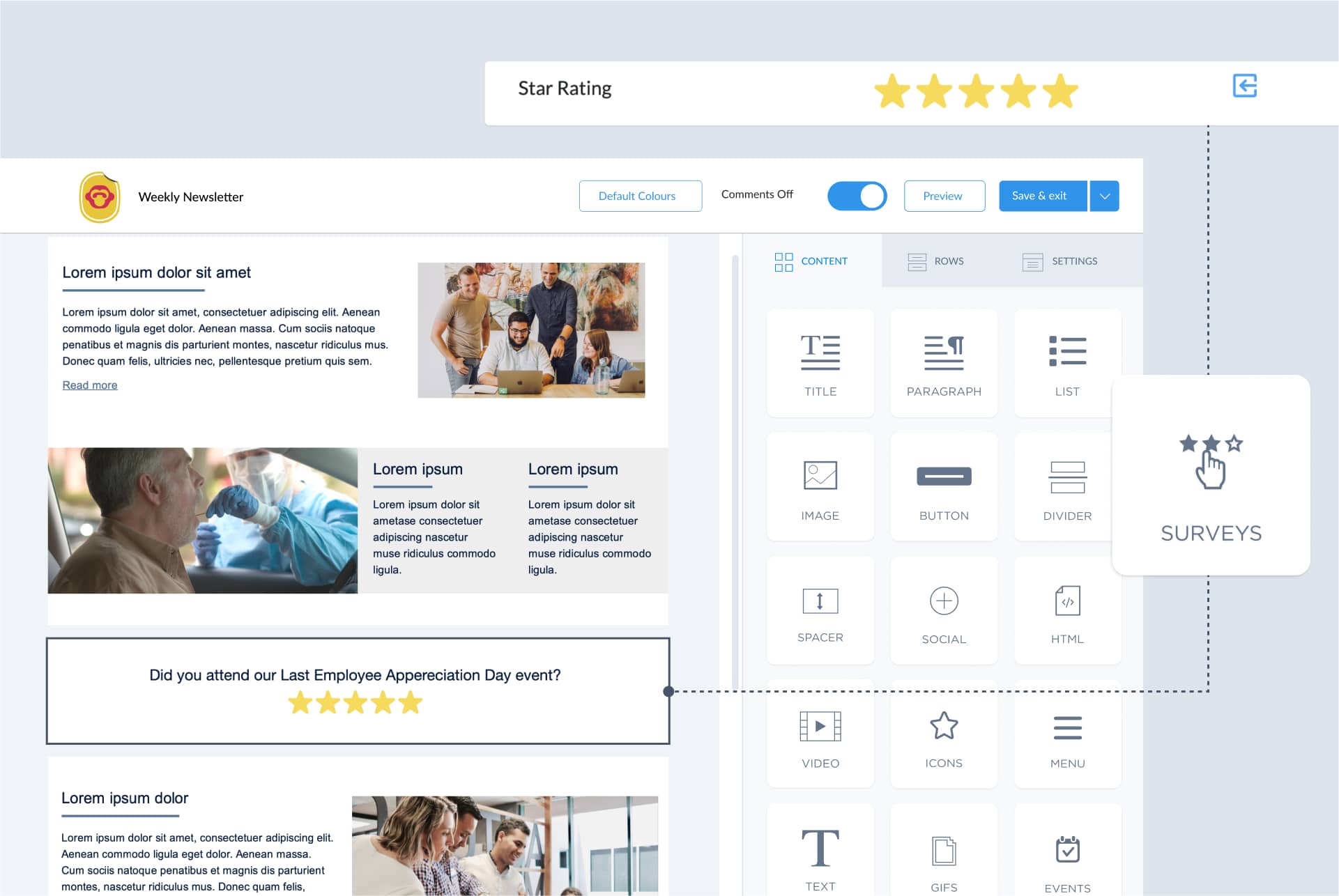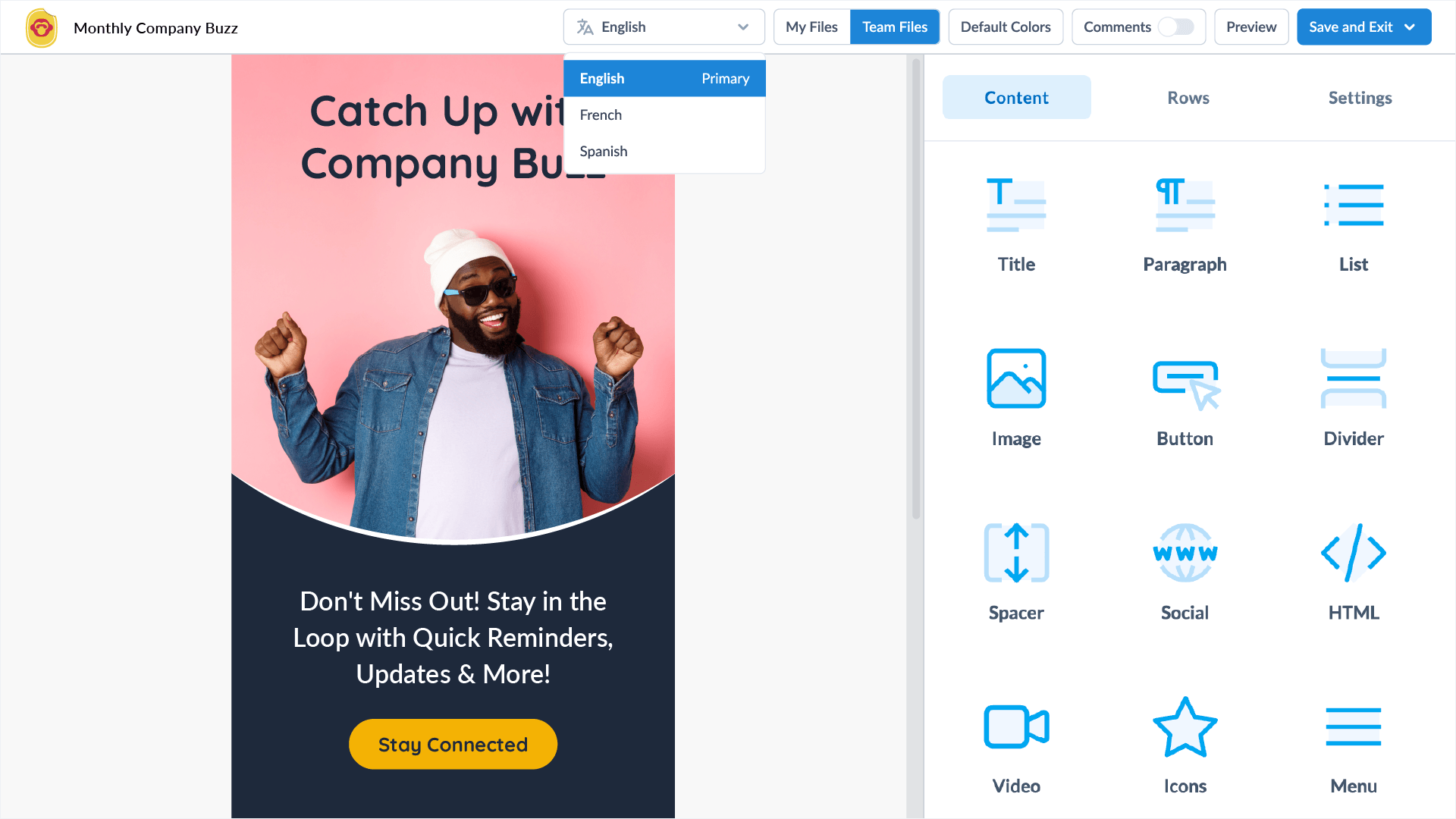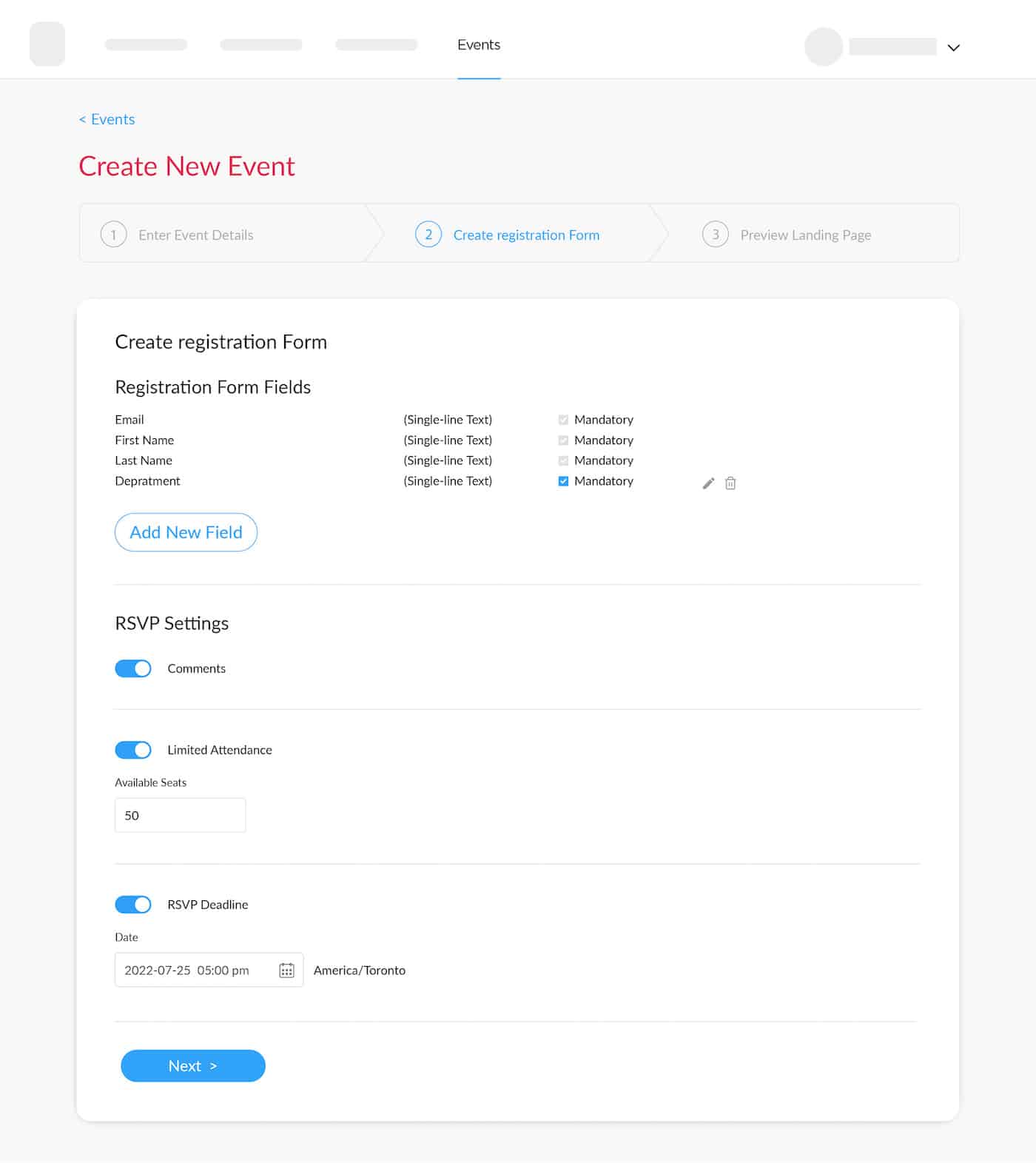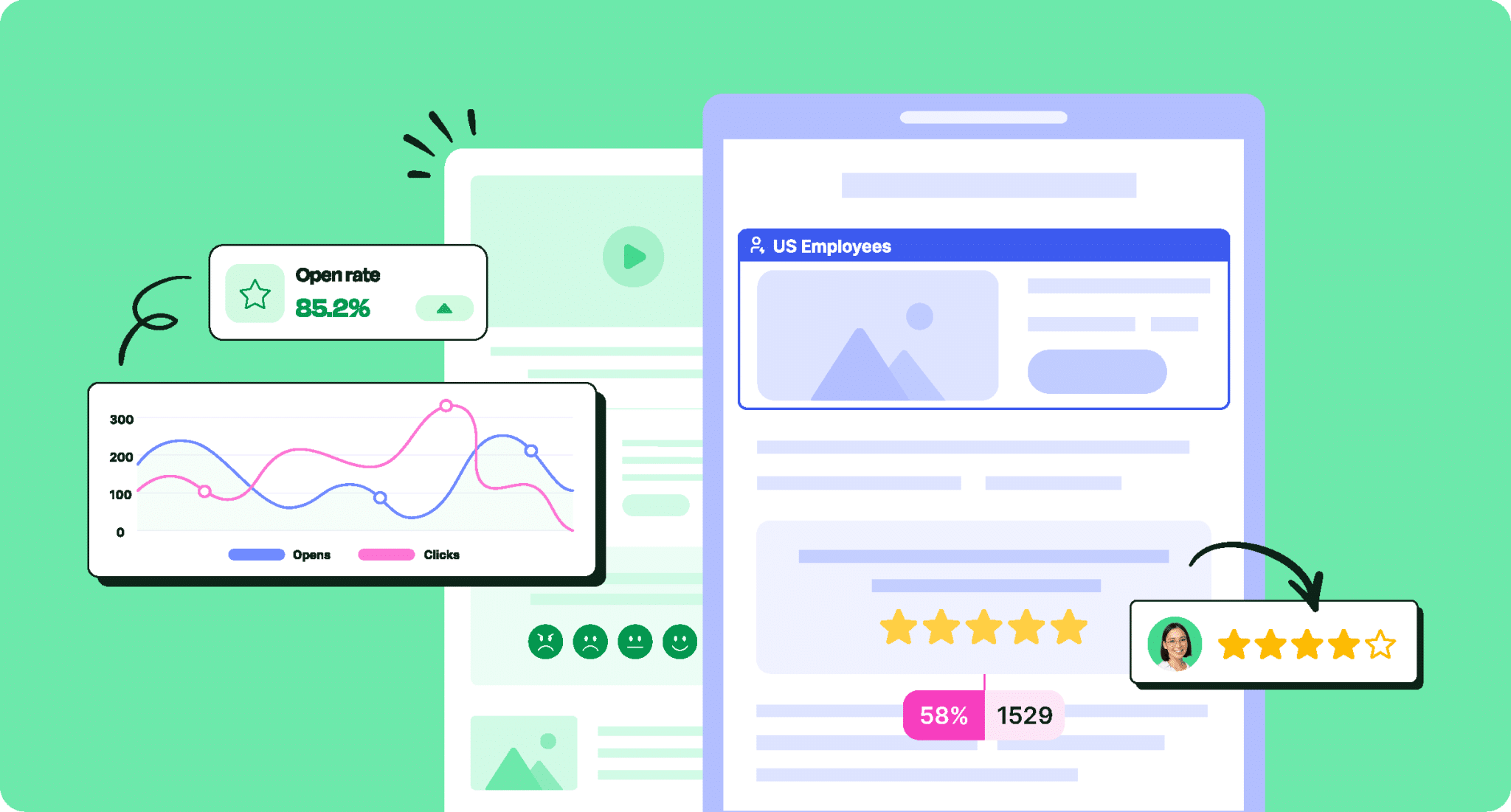Leveraging employee engagement technology helps you motivate workers, but many organizations don’t get the most out of their chosen employee experience technology. We share the best ways to improve employee engagement with technology in your organization.
In a Harvard Business Review survey, 91% of respondents said that high-quality digital tools are extremely, very, or moderately important to employee engagement. However, only 57% believed that their organizations made good use of digital tools. Despite the benefits of employee engagement technology, organizations weren’t willing or able to properly leverage engagement tools for employees.
From greater collaboration to more remote work flexibility, here are the top 10 ways to utilize technology for employee engagement.
Take a self-guided tour of ContactMonkey
See how our key features can streamline your internal communications.
Take product tour

1. Make Communication Easier Within and Between Teams
Employee engagement doesn’t just rely on an individual’s interest in their work! Workers feel most engaged when they work well with co-workers. On the flip side, even the most engaged employee loses motivation when collaboration fails or when crucial information falls through the cracks.
Fortunately, there are plenty of digital tools and channels available to make internal communication seamless and collaboration easier. Learn more about tools for internal collaboration and why you should use them.
Employee engagement solutions are designed to improve information sharing and cooperation within and between teams. However, all employee engagement technologies approach this differently, and each technology or tool offers unique benefits.
Some facilitate asynchronous communication, while others are better suited for more immediate comms needs. Because of this, organizations need to use a variety of tools to fully realize the impact of technology on employee engagement.
When looking for new employee engagement technology, look at multi-channel platforms and those that offer integrations with your existing tech infrastructure for maximum convenience.
Tools like ContactMonkey help you build striking HTML newsletters and emails and send them using your existing email service. For more immediate communication needs, like crisis comms, you can also use ContactMonkey to send out employee SMS. Plus, ContactMonkey provides you with robust tracking options that help you understand how employees are interacting with your messages, flag potential disengagement, and adjust your communication and engagement strategies in response to real-time data.
2. Make Remote Workers Feel Engaged
Without the right employee engagement technology solutions, remote workers are likely to feel disconnected from their team and the greater goals of their organization. Not to mention they’re more likely to miss crucial information.
Over time, these oversights can make it harder for remote workers to do their work. They may even miss out on important opportunities.
Luckily, conferencing tools like Zoom, messenger apps such as Slack or Microsoft Teams, and many other employee communication platforms exist to bridge the gap and engage remote employees. With the right strategy, these tools can not only reach remote employees but also keep them informed and help them feel like an integral part of the company.
Using these technologies also allows you to cast a wider net in both hiring and retaining talent. You can hire passionate employees from anywhere, ensuring your team is composed of individuals who truly believe in their work and the project. This broadens your talent pool and helps build a competent, engaged, and thriving remote team.
3. Provide Employees More Flexibility
When employees can work how and where they want to, they not only feel trusted but can also complete tasks in whatever way works best for them. That means higher quality work, happier employees, and of course—more engagement.
Task tracking and project management tools like Jira, Monday, and Trello make it easier for teams to coordinate large projects across distances and time zones. They also enable leaders to offer flexible work structure options, while feeling comfortable that employees will stay dialled in.
Workplace flexibility isn’t just a nice-to-have. For employees who have responsibilities like childcare, it can be non-negotiable. Digital communication and collaboration tools can allow them to meet their personal responsibilities while staying engaged with their work.
And the result is that employees feel empowered in their work and are less burnt out. They’re also more likely to recommend their job as a good place to work, making your organization a more competitive workplace for hiring. This helps to attract passionate, driven, and engaged employees.
Modern internal comms and measurement tools
No design or technical expertise needed. Save time, increase engagement, and dazzle your employees with fun and interactive communications.
Explore all features

4. Get Engagement Feedback Directly From Employees
To drive real, lasting employee engagement, organizations need to understand their employees’ wants and needs. And the best way to do that, of course, is to ask them.
Employee surveys provide both employee engagement metrics and detailed, specific qualitative information about the hows and whys of that engagement. Employers hear directly from employees what does and doesn’t work for them, when they’re feeling less engaged, and how to fix it.
Plus, employees appreciate being listened to. If you collect and implement employee ideas, they’ll feel more empowered in their work, more positive about their workplace, and will want to work harder to make the organization successful!
Employee engagement survey technologies come in different forms, but all employee survey tools exist to make surveying and analyzing employee feedback easier.Get a detailed look at how to create and conduct employee surveys.
Annual long-form surveys can provide a thorough picture, but embedding quick pulse surveys into your regular communications is a great way to collect data throughout the year without overwhelming employees.You can use ContactMonkey to embed pulse surveys into your regular newsletters and emails to get quick, immediate feedback from employees directly in their inboxes. Just drag a survey block into your newsletter and select the type of survey you want. Options include Yes/No, Star Rating, Emoji Reaction, eNPS surveys and more.
Implement these newsletter strategies to engage employees using ContactMonkey to boost staff participation.

You can even enable anonymous comments so that employees can add candid feedback on top of their survey responses.
Watch ContactMonkey LIVE in action
Join live demo

5. Remove Workplace Barriers With Accessible Design
Accessibility might not necessarily drive engagement, but a lack of accessibility in a workplace can certainly hurt it. Inaccessible workplaces present massive barriers for employees, leading to frustration, distrust, and ultimately, disengagement.
To accommodate employees, make sure that the new tools and technologies you bring in are as accessible as possible. For example, make sure software is compatible with screen readers, use video conferencing tools that provide live captioning, etc.
And remember—prioritizing accessible design benefits everyone in your organization!
The “curb cut effect” refers to a phenomenon where disability-friendly design ends up benefiting everyone. The name comes from sidewalk curb cuts, the inclined ramps that connect the sidewalk to the road at intersections. While these were originally meant for wheelchair users, it soon became clear that curb cuts made intersections easier for pedestrians, cyclists, and more!
The same principle applies to the design of digital tools and content. For example, proper heading hierarchy in digital content is very important for screen reader users, but also makes content easier to read for all employees in an organization.
For large international organizations, language accessibility is another way to make employees feel included. Companies often segment communications by location, assuming that regional languages will suffice. However, this approach overlooks the fact that some employees are more comfortable in a different language than the dominant language of their workplace. ContactMonkey’s multi-language email feature allows you to send a single multilingual internal email in up to four different languages that employees can toggle between.

6. Offer Employees the Opportunity to Grow and Upskill
Often, the role of technology in employee engagement is to provide broader and easier access to employee resources. Such is the case with technological solutions for employee training, upskilling, and continuing education.
Upskilling doesn’t need to include a technological solution, of course, but technology provides flexibility for both employers and employees. For example:
- Learning management systems like Litmos give employees access to vast course catalogues for learning new professional skills. They also allow employers and HR to upload internal training materials that employees will need.
- Digital libraries of education content help employees meet professional standards (such as continuing education requirements) without being limited to local courses.
- Digital learning also allows for asynchronous training that fits employee schedules.
- Communicating online lets employees cast a wider net when seeking mentorship.
Employees can feel disengaged when they don’t see room to progress in their chosen career or at their current job. When an organization facilitates education and skill-building, it shows that they’re willing to invest in that employee’s future. As a result, employees feel valued and want to participate more.


7. Make Work Feel Like Play With Gamification
Employee engagement platforms that gamify work tasks are a great way to use technology to improve employee experience and get employees more invested in their work. Gamification makes task completion fun and adds a layer of motivation that goes beyond traditional compensation.
Gamification isn’t just about individual motivation, either. It’s also a fantastic tool for team building! Both collaborative and competitive gamification bring people together and foster a sense of camaraderie and healthy competition. When gamified elements, like digital leaderboards and badges, make employee achievements more visible and prominent, it boosts morale and encourages others to strive for success.
Plus, gamification lends visibility to employee’s job tasks and encourages more collaboration across departments.
Gamification can also be an accessibility aid for employees with difficulty finding motivation through traditional methods.
And it bears repeating: it’s fun!
Learn more about how you can leverage gamification for employee engagement.
8. Implement Employee Recognition Initiatives
No matter how interesting someone’s job is, feeling like their work isn’t being appreciated will eventually drain their motivation. In fact, a lack of recognition is a very commonly cited reason for a lack of employee engagement.
While recognizing employees doesn’t require a tech layer, there are tons of tools out there that make it both easy and fun to highlight employee success!
With specialty tech tools like Kudoboard, employers and coworkers can spotlight those team members who go above and beyond. They also allow you to tie those kudos to real-life rewards for employees. Offering tangible rewards shows a level of commitment to employee morale and well-being that makes employees feel more loyal to an organization, fostering unity and cohesion.
9. Plan Team-Building Activities
A close-knit company boosts employee engagement, but building a strong culture takes effort and planning. One option? Team-building events.
Virtual activities are a great way to engage remote employees and grant employees who aren’t in-office full-time more flexibility.
Virtual event platforms like Kumospace help recreate some of the experience of being at an in-person event, allowing users to move and mingle through a virtual physical space. Activities like monthly coffee times, game nights, and trivia nights can also be seamlessly held over digital platforms to allow employees to connect and bond regardless of physical location.
Employee engagement technology, alongside other interactive tools, can be very useful in event planning.For example, with ContactMonkey’s event management feature, users can build events directly in their ContactMonkey dashboard, design custom registration forms, and then embed those forms into any email they send out.

Employees can RSVP to virtual events directly from their inboxes and receive an immediate calendar invite, and event planners can track registrations in ContactMonkey and collect any information that they need from attendees with the custom form fields.
Plus, ContactMonkey’s tracking features mean that if an event does not get the expected number of RSVPs, planners can check whether employees are opening the email and even re-send it to employees who have yet to respond.
Take a self-guided tour of ContactMonkey
See how our key features can streamline your internal communications.
Take product tour

10. Provide Clarity on Workplace Benefits
Another way to increase employee engagement using technology is to track employee benefits and keep employees informed about benefits they have access to.
These could include medical and dental benefits, but also PTO and sick day policies, wellness programs, retirement planning and funds, flexible spending accounts, and more.
These employee engagement technology solutions might look like:
- Hosting regular digital benefits seminars to update employees on their benefits and answer questions they may have.
- Using internal communication tools like intranets or employee portals to inform employees of changes to their benefits and provide interactive tools like a benefits calculator.
- Streamlining the PTO approval process with digital leave management systems to make it easier for employees to request and receive time off when they need it, thus reducing burnout and promoting employee wellbeing.
Having an employer emphasize that benefits are important and make sure that benefits and benefit information are accessible makes workers feel like they’re actually allowed to use their benefits. Employees feel valued and respected by their workplace.
Not only does that make an organization a more competitive place to hire, but it also reduces turnover, with employees being more likely to stay on because of a comprehensive benefits package.
Plus, healthy, well-rested employees will have a much easier time being engaged than employees who aren’t.
Discover these methods on how to create engaged employees and foster a positive work culture.
Start Improving Your Employee Experience Through Technology Today
Incorporating the right technology into your workplace will enhance employee engagement and overall satisfaction. To get the most out of your employee engagement technology, however, it’s key to find tools that work seamlessly together and integrate with your existing tech infrastructure.
The right technology offers numerous ways to create a more dynamic and inclusive work environment, from enhancing communication to ensuring accessibility to communicating employee benefits and much more.
Want to not only enhance but also track your employee engagement? Book a free demo of ContactMonkey today to get started.



